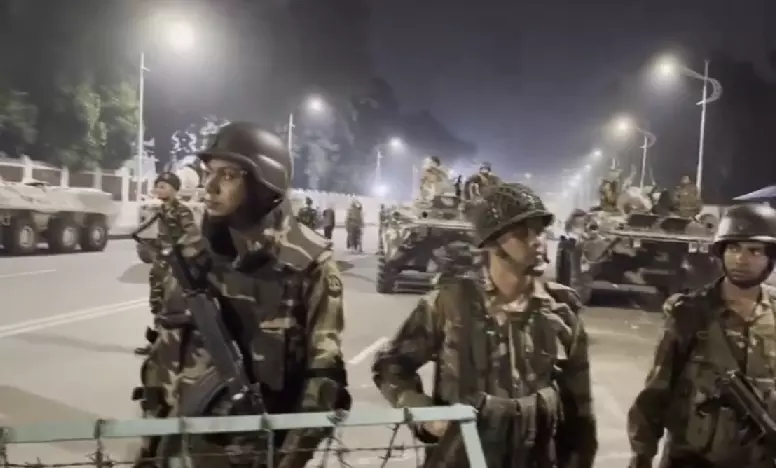
Fresh protests break out in Bangladesh as students try storming presidential palace
The protesting students have demanded President Mohammed Shahabuddin to resign for his recent comment on the resignation of deposed prime minister Sheikh Hasina

In a fresh spate of unrest, hundreds of protesters tried to storm the presidential palace on Tuesday (October 22), demanding President Mohammed Shahabuddin’s resignation for his recent comment on deposed prime minister Sheikh Hasina.
In an interview with Bangla daily Manab Zamin last week, Shahabuddin said he did not have any documentary evidence of Hasina resigning as prime minister before she fled the country on August 5 amidst student-led mass protests.
Protest turns violent; 2 injured in police shooting
Witnesses and TV footage showed protestors under different banners scuffling with police as they barred the demonstrators from entering the Bangabhaban, the official residence of the president.
The police eventually fired sound grenades, prompting army troops to later intervene and then send policemen inside the palace.
The situation eased a little as the military using loudspeakers requested agitators to leave the Bangabhaban gate.
Also read: After July uprising, seeds of anarchy sprout in Bangladesh again
The Business Standard, a Bangladeshi daily, quoted hospital sources as saying that two people sustained gunshot injuries when security forces fired shots to contain protesters from breaking the barricades of the presidential palace.
It said a third person was wounded by a sound grenade used to create a sound explosion to disperse violent mobs.
Students’ body gives 7-day deadline to Shahabuddin
The Anti-discrimination Student Movement, which spearheaded the campaign that led to the ouster of Hasina, rallied in front of the Central Shaheed Minar, demanding Shahabuddin’s resignation.
It set a seven-day deadline for Shahabuddin’s removal as they laid a five-point demand, including the scrapping of Bangladesh’s 1972 Constitution.
“Our first point (of the five-point demand) is immediate scrapping of the 'pro-Mujb (Bangladesh’s founding leader) 1972 Constitution' which kept Chuppu (president’s nickname) in office,” said Hasnat Abdullah, one of the coordinators of the Anti-Discrimination Students Movement.
Abdullah, who spoke as the concluding speaker of a massive rally at Central Shaheed Minar in Dhaka, said: “The (1972) Constitution will have to be replaced by writing a new one against the backdrop of 2024 mass upheaval."
Also read: A Federal Ground Report: Islamist, secular, or Bengali? Bangladesh hunts for an identity
‘More protests if demands are not fulfilled’
He said the protestors would "return to the streets with full force" if the government failed to meet the demands by this week.
Several other groups under different banners joined Tuesday’s protests alongside the Anti-Discrimination Students Movement at the premier Dhaka University campus, Shaheed Minar, and Bangabhaban.
Law affairs adviser, equivalent to minister, of Professor Muhammad Yunus’ interim government Asif Nazrul earlier accused Shahabuddin of “falsehood” saying his remarks were “tantamount to violation of his oath of office”.
He added that if he remained firm on his comments the interim government would need to think whether he was still qualified to hold his office.
Did Shahabuddin lie?
In a televised address on August 5 night, Shahabuddin said: “You know Prime Minister Sheikh Hasina has tendered her resignation letter to the president and I have received it.” He made the remarks as army chief General Waker uz Zaman along with navy and air chiefs stood beside him.
Nazrul on Tuesday said that despite his nationwide speech, if Shahabuddin now declines to have received the resignation letter, it would mean that one of his two statements are false and that would make him face the charge of falsehood.
The law affairs adviser along with information ministry adviser Nahid Islam, also a leader of the Anti-Discrimination Students Movement, later held a nearly 40-minute close-door meeting with Chief Justice Syed Refaat Ahmed amid media speculation that it could have centred on the modus operandi of removing the president.
Also read: Sheikh Hasina should be extradited, Bangladesh hardens its stance
What next for president?
Constitution expert Shahdhin Malik said Bangladesh’s Parliament has the authority to impeach the president but the "interim government may take any action (against the president) as many things are now happening beyond the law".
Malik also said an “unnecessary debate is going on over the documentary evidence of Hasina’s resignation letter amid the existing reality".
“After the toppling of Sheikh Hasina’s government, the interim government has been formed based on the Supreme Court’s opinion... no debate is required about it,” he said.
Bangabhaban, meanwhile, in a statement said the president urged the people not to reignite controversy over a “settled issue”.
Also read: Reporter's account | Hasina to Yunus, what Bangladeshis look for in transition
“This is a clear statement from the president that answers regarding the resignation and departure of the former prime minister (Hasina) in the face of the students-people mass revolution, the dissolution of the Parliament, and all the questions raised in the public mind about the Constitutional validity of the incumbent Interim government are reflected in the order of the Appellate Division of the Supreme Court in Special Reference No-01/2024, dated August 8, 2024,” the statement said.
Nobel laureate Muhammad Yunus, 84, became Bangladesh's interim government's Chief Adviser on August 8 after Prime Minister Hasina fled to India on August 5.
(With inputs from agencies)

